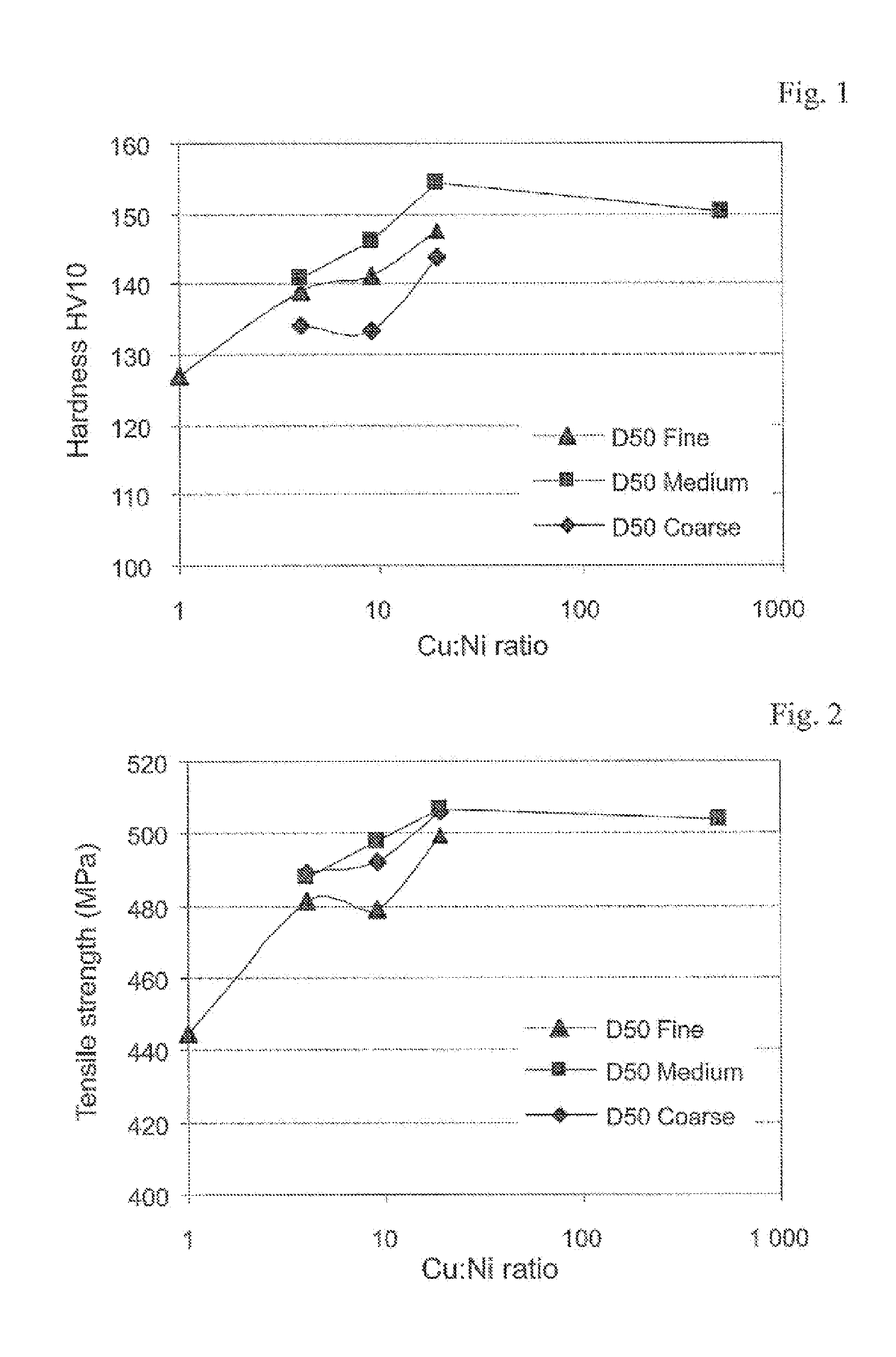Method of producing a diffusion alloyed iron or iron-based powder, a diffusion alloyed powder, a composition including the diffusion alloyed powder, and a compacted and sintered part produced from the composition
a technology of diffusion alloying and iron-based powder, which is applied in the direction of coatings, layered products, metal layered products, etc., can solve the problems of affecting the sintering effect of the iron-based powder
- Summary
- Abstract
- Description
- Claims
- Application Information
AI Technical Summary
Benefits of technology
Problems solved by technology
Method used
Image
Examples
example 1
[0057]Three samples of diffusion bonded iron-based powders were produced by first blending different alloying powders, cuprous oxide Cu2O, Cu2O+Ni powder and a Cu and Ni containing powder with a iron powder, ASC100.29.
[0058]The homogenous blended powder mixes were diffusion annealed at 800° C. for 60 minutes in an atmosphere of 75% hydrogen / 25% nitrogen. After diffusion annealing, the weakly sintered powder cakes were gently crushed and sieved to a particle size substantially below 150 μm.
TABLE 1Ni contentDiffusionCu / NiD50Cu contentin diff.annealedAlloyingratioalloyingin diff.annealediron-basedpowderof alloyingpowderannealedpowderpowderusedpowder[μm]powder [%][%]1 (reference)Cu2O100 / 08.81002 (reference)Cu2O +100 / 08.8Ni 0 / 1008.5913 (invention)Cu—Ni 9 / 18.591alloypowder
[0059]Table 1 shows particle size, D50, and ratio of Cu and Ni of the alloying powders as well as Cu and Ni content of the diffusion annealed powders. The mean particle size, D50, was analyzed by laser diffraction in a ...
example 2
[0064]Various types of copper / nickel containing alloying powder according to Table 3, having different ratios of copper and nickel as well as different particle size distribution, were used as copper and nickel containing alloying powder. As reference a cuprous oxide powder, Cu2O, available from American Chemet was used. The particle size distribution was analyzed by laser diffraction in a Sympatec instrument. In order to simplify the evaluation, powders having D50 less than 8.5 μm was designated as “fine”, between 8.5 μm and less than 15.1 μm was designated as “medium” and above 15.1 as “coarse”.
TABLE 3Iron-based diffusionannealed powder No.Ratio Cu / NiD50 μm 1 (reference)∞8.8(medium) 2197.1(fine) 3199.9(medium) 41915.5(coarse) 594.7(fine) 6910.1(medium) 7921.1(coarse) 844.2(fine) 948.5(medium)10415.1(coarse)1116.4(fine)
[0065]As base powder, a pure iron powder, ASC100.29 available from Höganäs AB, was used.
[0066]Various samples having a weight of 2 kg of diffusion bonded powder were...
PUM
| Property | Measurement | Unit |
|---|---|---|
| particle size distribution | aaaaa | aaaaa |
| temperature | aaaaa | aaaaa |
| particle size | aaaaa | aaaaa |
Abstract
Description
Claims
Application Information
 Login to View More
Login to View More - R&D
- Intellectual Property
- Life Sciences
- Materials
- Tech Scout
- Unparalleled Data Quality
- Higher Quality Content
- 60% Fewer Hallucinations
Browse by: Latest US Patents, China's latest patents, Technical Efficacy Thesaurus, Application Domain, Technology Topic, Popular Technical Reports.
© 2025 PatSnap. All rights reserved.Legal|Privacy policy|Modern Slavery Act Transparency Statement|Sitemap|About US| Contact US: help@patsnap.com


